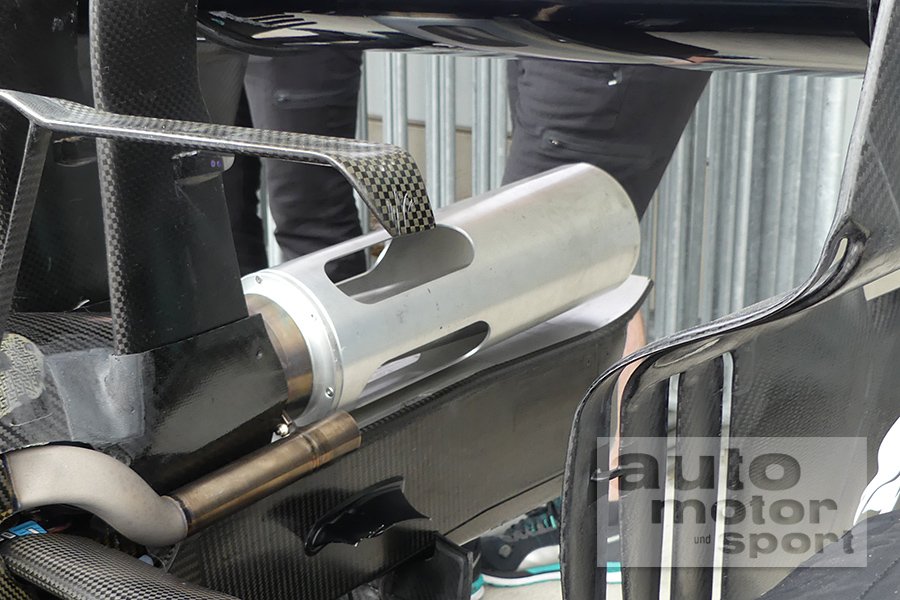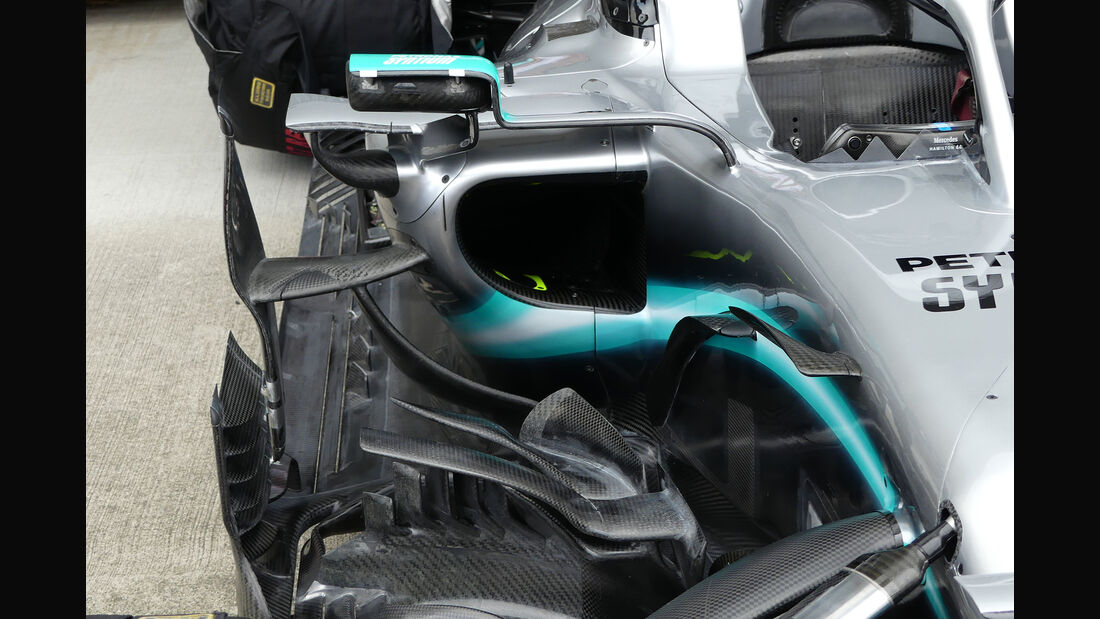

Side pod vanes (detail-focused comparison shots):


Exhaust position measurement device:










This was probably leftover from before they stopped development, thus taking little effort to actually finish the updateLM10 wrote: ↑09 Oct 2019, 18:06That's a pretty major bargeboard upgrade. Turns out they didn't (totally) shift their resources to next season yet. This isn't a reaction to Ferrari's recent form as it surely took longer than 2.5 weeks (time since Singapore when Ferrari upgraded their car) to make this upgrade ready.
Thanks







Lately, due to the law of diminishing returns fuel has become a critical performance factor once again. Since 2018 they are allowed 3 homologated fuel for the entire season and one fuel specification represented a 1 to 1.5% horsepower increase, depending on the operating conditions. Thus, over an entire season, around half of the gains recorded on the ICE comes only from the fuel.zibby43 wrote: ↑07 Oct 2019, 04:45...
Completely agree re: the fuel/lubricants. They're definitely in the "low-hanging fruit" category of PU performance gains these days.
With respect to the PU, I heard somewhere (think it may have been SomersF1) that Merc have been forced to run the Spec 3 PUs in lower modes under race conditions due to reliability concerns.

One of the easiest for a while I think because the rules are stable and a big change due in 2021. Next years cars will likely just be evolution's of this years. I doubt any team, unless your near the bottom, are going to go for a major overhaul and direction change just for 1 year. In fact even if your near the bottom why bother. So every update that works this year is an advantage for next year.


formula1.comBottas is optimistic about the performance gains he expects from the new parts.
“We have a pretty solid update package this weekend,” he said on Thursday in Suzuka. “Obviously getting to try that tomorrow, how it works, but in theory, yes it should give us more performance. How much actually, that’s something we’ll find out. We have some rough numbers about it but should be a decent step in terms of if we’re talking about upgrade packages so far. We shall see.”
Less car that interacts with the air. What's better for low drag than less car?
This was an informative read; thanks for sharing!atanatizante wrote: ↑10 Oct 2019, 11:33Lately, due to the law of diminishing returns fuel has become a critical performance factor once again. Since 2018 they are allowed 3 homologated fuel for the entire season and one fuel specification represented a 1 to 1.5% horsepower increase, depending on the operating conditions. Thus, over an entire season, around half of the gains recorded on the ICE comes only from the fuel.zibby43 wrote: ↑07 Oct 2019, 04:45...
Completely agree re: the fuel/lubricants. They're definitely in the "low-hanging fruit" category of PU performance gains these days.
With respect to the PU, I heard somewhere (think it may have been SomersF1) that Merc have been forced to run the Spec 3 PUs in lower modes under race conditions due to reliability concerns.
The main focus on fuel is to get more energy from the same amount of fuel - 110kg - and that is crucial coz drivers can start the race with less fuel which means less weight (hence faster lap times), better start and less tyre&brake wear.
The energy that`s coming out of the fuel when it burns correlates to a specific calorific value. Higher this value higher the energy. And here comes into play the fuel formula. Due to the rules, Grand Prix fuel composition is almost close to the commercial fuels and almost meaning less than 1%.
This per cent is comprising of more than 120 chemical compounds but is also restrictions regarding those. Into this equation enters the octane number – ON - and any component of fuel that is good for the ON is bad for the energy. It`s important to have a higher ON (but not over 100) in order to have a higher calorific value hence energy but then, the downsides come that the detonation&knocking it`s increasing. So there`s always a challenge to find innovative fuel formulas which has a compromise between energy density and detonation&knocking.
However, there`s an interesting and not so well known fact regarding fuel density and I quote bellow Total’s assistant scientific director Philippe Girard which said the followings :
“The regulations establish broad guidelines in terms of fuel because it cannot be too removed from the one used in regular road-going cars, but then we are free to play on the proportions. For instance, you can incorporate a greater amount of light molecules, and thus continue to proceed as during the V8 era. One of our competitors [Shell] has tried to do just that actually. So a fuel that is less dense, which often means it has a higher energy content, will occupy a greater volume for the same weight. 1kg of light fuel fills 1.4L – against 1.3L for a denser one – and obviously, there is more energy in 1.4L. But since it takes up more space, chassis engineers will be forced to design a bigger fuel tank.”
On this note, rumours are saying that Shell has the upper hand regarding the lightest fuel on the grid, hence the highest energy density fuel from all petrol companies in F1 involved.
But what Mr.Girard is not saying is that it`s at least another factor that influences fuel density which is temperature.
https://postimages.org/
The higher it is the lower density in our case as we could see from bellow picture and I don`t understand why Merc was caught in Singapore for a much cooler fuel than the regs allowed. Maybe it`s used to act as a heat sink?
I think it`s counterintuitive but I made this assumption, as we could see from the picture above, had the fuel temps lower the viscosity is increasing and obviously density is increasing hence lower energy density.
But maybe with the addition of advanced nanoparticles of WS2 (wolfram or tungsten disulfide, tungsten being the „smoothest” element known to science), they`ve already solved this issue... btw. WS2 has at least twice better performance than MoS2 (Molybdenum disulfide) as numerous oil tests confirm that ...
Yeah, but they're trading a relatively small portion of bodywork with two pretty strong vortices, so it's probably more downforce-centered rather than drag reduction. Although the Ferrari-style bargeboard upgrade might mitigate that a bit.godlameroso wrote: ↑10 Oct 2019, 20:47Less car that interacts with the air. What's better for low drag than less car?